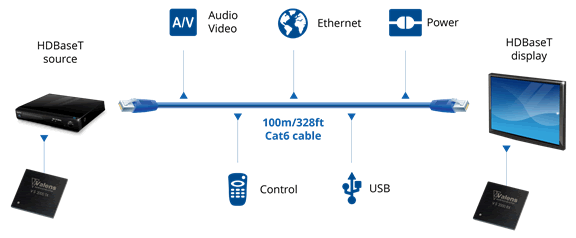Curbing Complexity in AV Connectivity with HDBaseT
HDBaseT leverages common cables and connectors while providing the high performance needed for the increasingly complex world of audiovisual technologies.
By Daniel Shwartzberg, Manager of Customer Experience for the HDBaseT Alliance
The world of audiovisual (AV) technology has evolved dramatically over the past two decades. The move from analog to digital has led to thinner displays, higher resolutions, and more devices that enable content viewing. While 30 years ago, the only thing televisions connected to were antennas, and possibly a VCR, today’s flat-screen TVs are connected to set-top boxes, media streamers, gaming consoles, Blu-ray players, AV receivers, surround-sound systems, and more. And that’s just in an average home installation.
When it comes to professional AV installations, the number of connections and data types increases. Controls such as RS-232, infrared, Ethernet, and even USB are all part of a plethora of additional cables and protocols that such high-end installations demand. HDBaseT has become a significant factor by providing high-speed performance with common Cat cabling and RJ-45 connectors.
Without a doubt, today’s viewing experience far exceeds that of the analog era. Ultra-HD video formats, deeper colors, and unrivalled audio capabilities allow home viewers to experience the ultimate in AV quality. However, while the focus is always on what is seen and heard, it’s what goes on behind the scenes that present some of the greatest challenges.
Cables are the arteries that feed an AV system. Many of these cables are hidden behind furniture or within walls. This creates some challenges in terms of the connectors that provide the physical interface with the AV equipment. Since digital AV signals are usually high-frequency, it’s crucial to ensure that connectors don’t degrade the integrity of the signals passing through them. Robust installations benefit from connectors that lock into sockets, rather than relying on the tightness of physical fit to hold them together. Feeding cable through narrow conduits in walls, ceilings, and floors becomes more difficult — if not impossible — given the size of the connectors and number of cables involved. Here’s a more detailed look at the challenges.
High-Grade Connectors
Increases in signal speeds have forced improvements in connector technology. Signal degradation within a connector can result from electromagnetic fields being converted into heat, but this is generally minimized due to the short size of most connectors. Instead, issues such as crosstalk and reflections can have direct and drastic effects on signal integrity. The differential signaling used in many data links can also introduce noise resulting from asymmetry in the wire lengths within differential pairs. Fortunately, most companies that produce high-speed connectors have teams of signal integrity experts working on designs. As a result, the quality of high-grade connectors has greatly improved over the years.
Locking Connectors
When a connector is plugged in, we expect it to stay there. This is especially important when the connection is not accessible because it’s on the back of a display or tucked away behind heavy furniture. Surprisingly, most AV connectors do not have a locking mechanism. HDMI, the most common AV connector, relies on friction to hold it in place. The same is true for frequently used audio connectors, such as RCA and TOSLINK, which can be easily dislodged from their sockets. USB also relies on physical fit. Ironically, it is the now near-obsolete VGA connector that provides the best locking mechanism, with screw terminals providing mechanical robustness in the face of even the strongest mishandling.
Feeding the Cables
Almost every cable in AV installations comes with a molded connector at both ends. HDMI, TOSLINK, USB, RS-232 – none can be field-terminated. What does this mean to an AV installer? First, they need to buy cables that come as close as possible to the required length. Since cable vendors don’t make cables to match every possible installation, unnecessary cable waste and clutter can be minimized with proper length selection. Second, connector size can provide a physical hindrance when feeding cable through conduits, especially when a conduit is already partially full. In such cases, there is also a risk of damaging the sensitive high-grade connectors, which can lead to reduced signal integrity and even connector failure.
Connecting AV the HDBaseT Way
Since its launch in 2010, HDBaseT has revolutionized the way AV systems are installed. The HDBaseT 5Play feature set allows ultra-high-definition audio and video, controls, 100M Ethernet, USB, and even 100W of DC power on a single, standard Cat cable. It’s no wonder that HDBaseT has quickly become the de-facto standard for AV connectivity.

Figure 1: HDBaseT uses common Cat cabling with a unique chipset that optimizes performance.
The beauty of using Cat cables is not only that they are inexpensive, but they can be field-terminated to the exact required length with run-of-the-mill RJ-45 connectors. These same cables and connectors have been used for years in IT network installations, but have only just been given a new lease on life in this groundbreaking AV application.
RJ-45 connectors seem simple, but they tick all of the boxes required for HDBaseT high-speed signaling and usage while simultaneously simplifying overall AV installations. Cat5e-graded RJ-45 connectors have the capability to reliably carry the 8Gb/s HDBaseT bandwidth, providing the necessary signal integrity to ensure worry-free installations, and their small, plastic locking tabs reliably prevent unwanted cable disconnections and offer positive feedback that the connection was fully made. RJ-45 connectors are also easily crimped in the field, which means an end to unnecessary cable waste. Further, with these connectors, feeding unterminated Cat cables through already stuffed conduits presents no challenge at all.
A time of rapidly evolving AV technologies requires new approaches to common problems. The use of the right cabling and connectors is critical to ensure that AV installations are fast, friendly, and reliable, and it’s the simple, ubiquitous RJ-45 that has proven to be the ultimate connector in an HDBaseT world.
Recently posted:
[related_posts limit=”10″]






